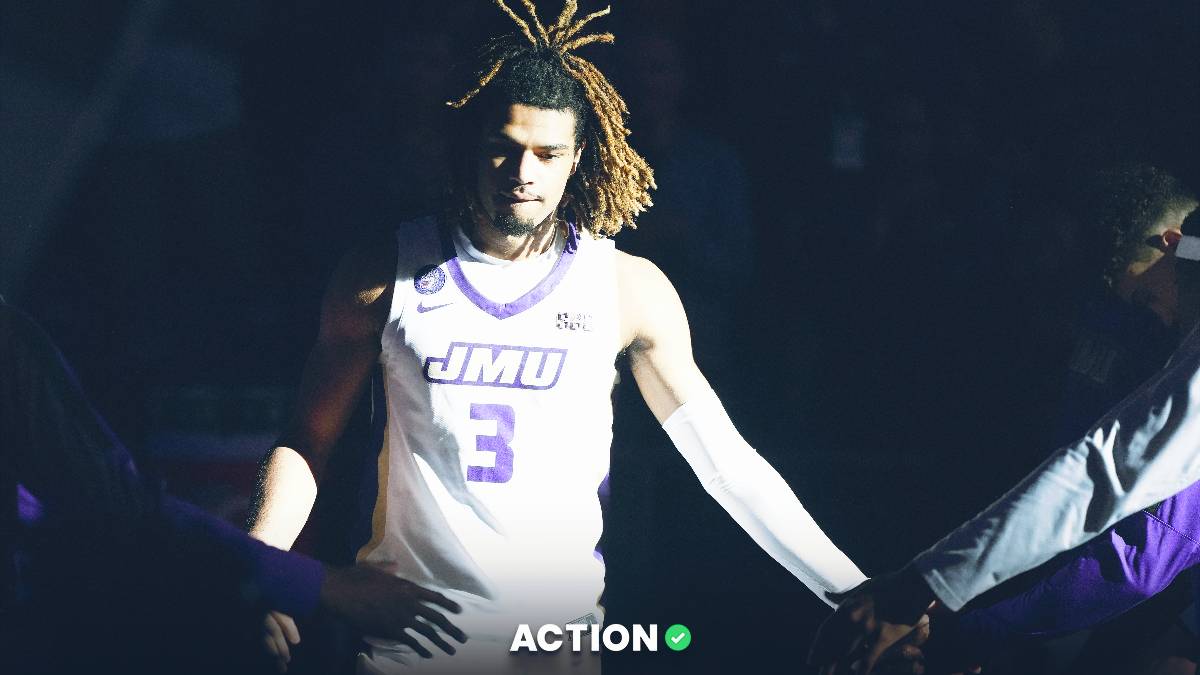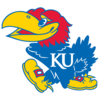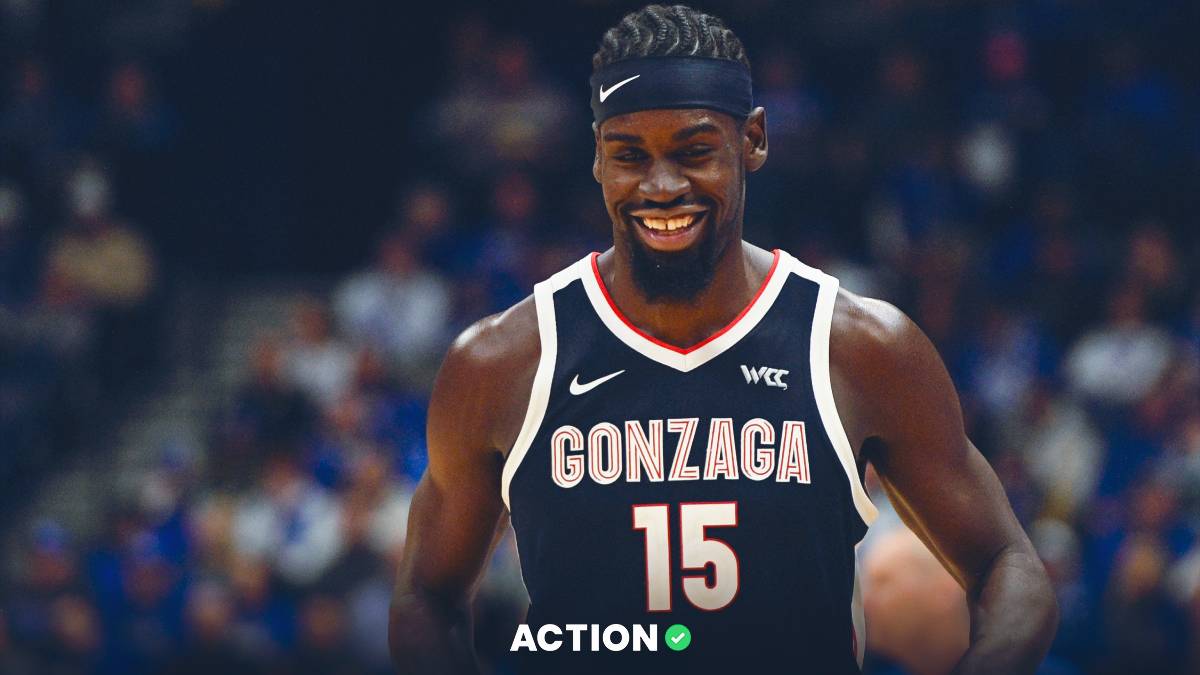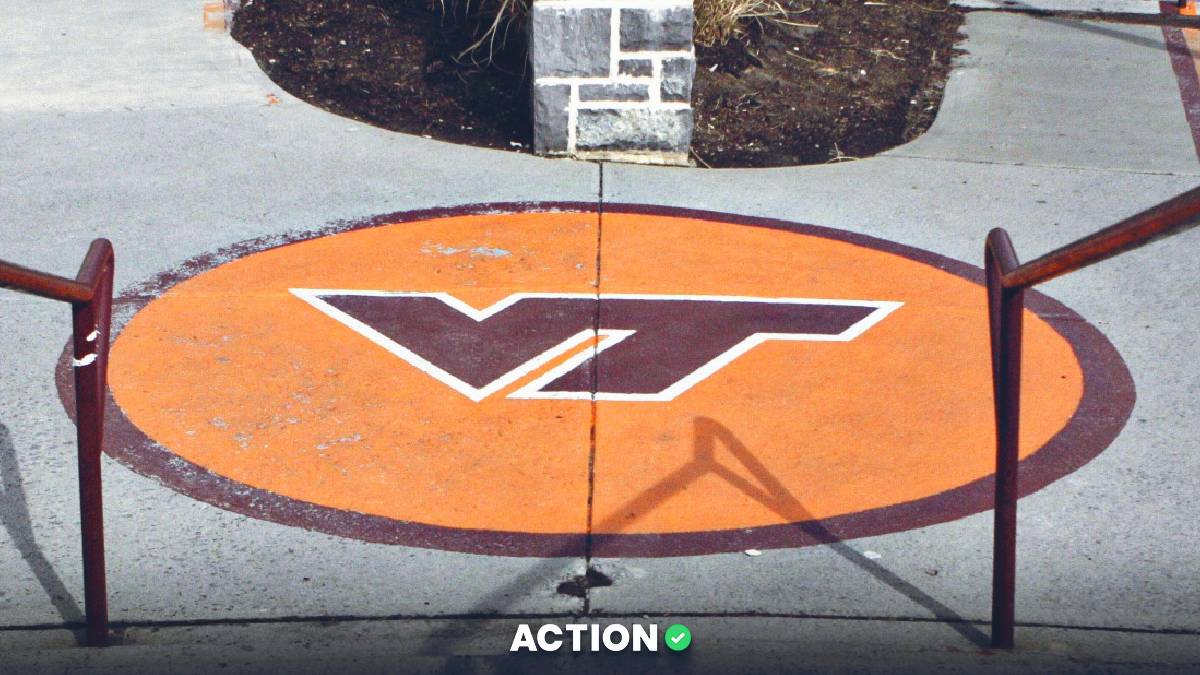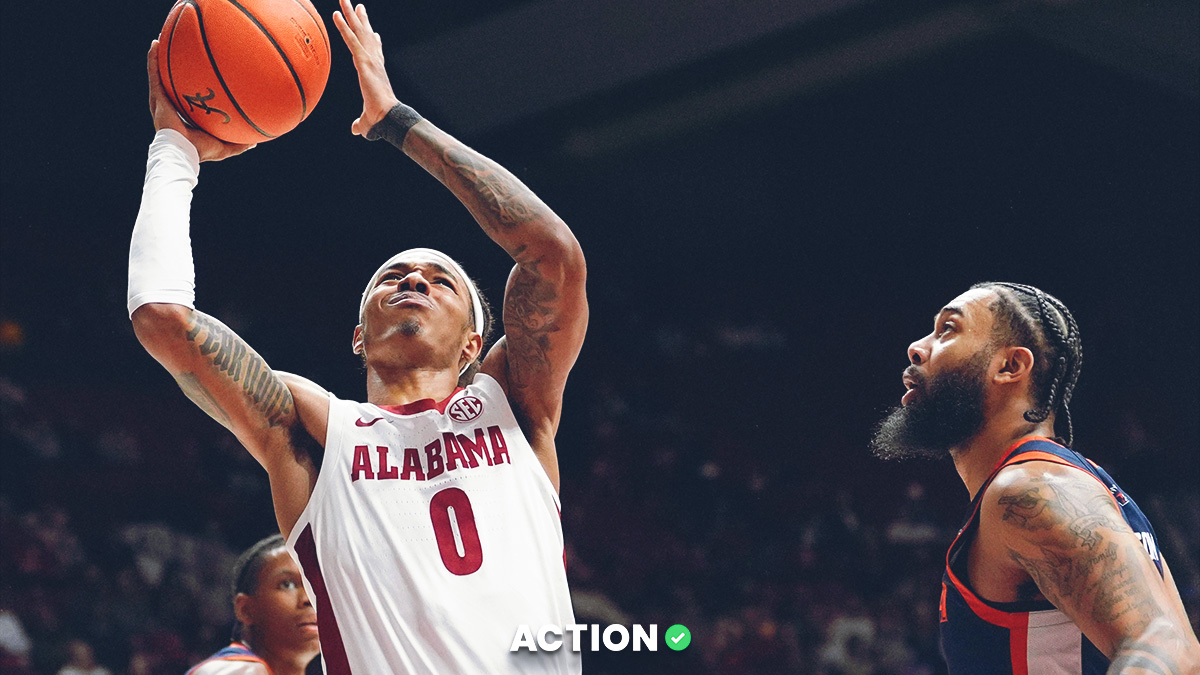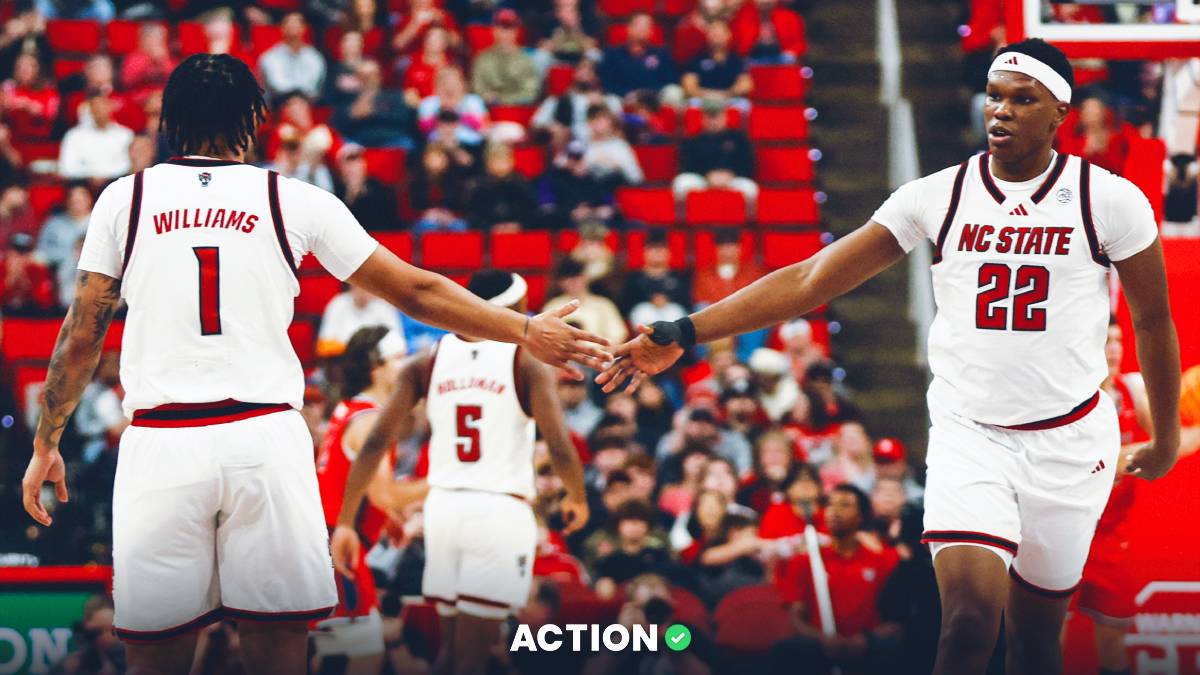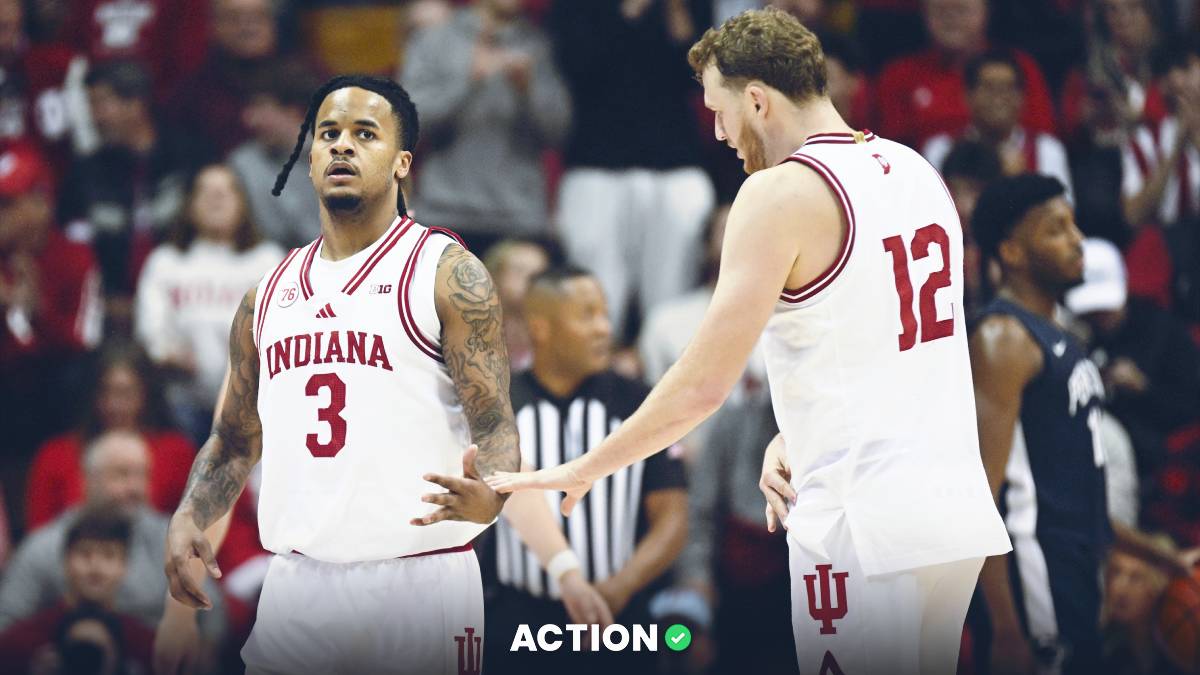Mike Calabrese and Tanner McGrath are back for another edition of our Pick & Roll. The dynamic duo has NCAAB predictions for Saturday.
McGrath's 2 Saturday Picks
Albany vs. Vermont
Since I’m widely known as The Action Network’s America East guru, I thought I’d take some time in our two-man weekly column to share my favorite wager from the conference tournament's first round.
For context, the higher seed hosts the AmEast tournament, so this game will be played at Patrick Gymnasium in Burlington. I just received my media credentials for the tournament games, so I’ll actually be covering Vermont’s hopeful dominance from the press box.
Look, the Great Danes are crazy dynamic, specifically on offense. Sebastian Thomas is among the quickest guards I’ve seen in this conference. Tyler Bertram, Amar’e Marshall and Aaron Reddish are three human microwaves who relentlessly push the pace and attack the rim but can get hot from all three levels.
But Albany is among the worst defensive teams I’ve seen play this year.
The Danes have actually gotten quite fortunate on that end this year, given opponents are shooting under 30% from 3. They play a drop-coverage defense that mostly denies 3-point opportunities, but they also rank last in the conference in Open 3 Rate Allowed.
Despite leading the conference in 3-point rate allowed, they’re allowing nine unguarded catch-and-shoot jumpers per game, which ranks fifth.
Yet Albany still ranks dead last among AmEast squads in Defensive Efficiency because the interior defense is so porous that any 3-point variance, regression, non-regression, or whatever doesn’t matter.
The defending America East Rookie of the Year and Albany center Jonathan Beagle left the program for personal reasons in early February, forcing head coach Dwayne Killings to play small-ball lineups featuring the 6-foot-7 Reddish at the five.
He tried to pull a Nate Oats, attempting to overcompensate for zero rim protection or rebounding with a small-ball, up-tempo, pace-and-space offense.
Well, it didn’t work, as the Danes lost eight of 10 down the stretch by allowing 44 paint points per game on 60% shooting from 2-point range. As a result, Albany allows six more paint points per game than any conference team on a 2-point clip four points higher than any other squad.
They’re horrible against cutters (1.35 PPP allowed, last in AmEast by .15), roll-men (1.19 PPP allowed, second-to-last), post-up sets (1.07 PPP allowed, last by .10) and other secondary actions designed to attack the rim – Marshall was abused by opposing frontcourts.
Altogether, Albany ranks sub-320th nationally in at-the-rim PPP allowed (1.25) while allowing the most at-the-rim field goal attempts per game.
Vermont runs a five-out motion offense designed to attack opposing offenses from 3, which theoretically doesn’t work well for this matchup.
However, when the Cats fail to find an open shooter, they shapeshift into ball-screen mode, hunting Matt Veretto, Nick Fiorillo or Ileri Ayo-Faleye on the hard roll, who then hunt cutters off the short roll.
And they’re great at it, leading the league in cutting PPP (1.32) while ranking third in post-up PPP (1.01) and roll-man PPP (1.08).The Cats led the league in 2-point shooting (55%) for a reason.
So, predictably, across two head-to-head meetings, Vermont scored a whopping 49 points on 29 cutting and roll-man sets – an insane 1.7 PPP – en route to 86 paint points on over 70% 2-point shooting.
The Cats won both matchups by double-digits, dropping 81 and 94 despite shooting 14-for-46 (30%) from 3. Again, 3-point variance doesn’t apply to Albany’s interior defense.
Meanwhile, when Albany tries to overcompensate offensively with its dynamic offense – the Danes do rank third in the league in Offensive Efficiency – it’ll be running a transition-reliant, rim-reliant offense into the nation’s best transition-denial and league’s best rim-denial defense.
The Danes lead the league in fast-break points per game (14) while ranking in the top 10 nationally in tempo and the top 50 in transition frequency. They also rank second in the league in paint points per game (39) and in the top 30 nationally in rim rate.
But guess what? Vermont’s five-out motion ignores offensive rebounds in favor of getting back on defense, so the Cats lead the nation in fast-break points per game allowed (five).
Meanwhile, Shamir Bogues and Ayo-Faleye have transformed Vermont’s defense, with the Cats leading the league in paint points per game allowed (30) and 2-point shooting allowed (45%).
I talked a bit about Vermont’s transition-denial defense on the Big Bets on Campus Podcast:
Albany is part of this new wave AmEast style, and the Danes have tried sprinting toward Vermont to no avail. Dwayne Killings ran right into John Becker's hands.
Vermont held Albany to two of its three lowest paint point totals of the season. The Cats held the Danes to .69 transition PPP across both head-to-head meetings.
The Danes went 6-9 ATS on the road this year. The last time they played at Patrick, Albany scored 30 paint points and zero fast-break points in a 22-point loss, and that was with Beagle.
I can’t see them keeping it within 20 this time around. Even if Matt Veretto and TJ Hurley are unavailable due to injury.
Pick: Vermont -14 | Play to -15
North Carolina vs. Duke
North Carolina-Duke is always a monstrously hyped-up matchup.
But this Saturday’s rendition of the sport’s best rivalry brings extra intrigue.
Duke (15-4) sits a game behind North Carolina (16-3) in the ACC standings, with the Heels having won the first head-to-head meeting in Chapel Hill. A Tar Heel win means the regular-season conference title and the top seed in the tournament is all wrapped up.
However, a Duke win means the two split the season series, and that’s when tiebreakers kick in.
As written on the ACC website:
a. When two teams are tied in the standings, regular season head-to-head results are used as the tiebreaker.
b. If the tied teams played each other twice in the regular season and split their games, then each team’s record against the team occupying the highest position in the final regular-season standings (or in case of a tie for first place, the next highest position in the regular-season standings) and then continuing down through the standings until one team gains an advantage. 1) When arriving at another pair of tied teams while comparing records, use each team’s record against the collective tied teams as a group (prior to their own tiebreaking procedures), rather than the performance against the individual tied teams. 2) When comparing records against a single team or a group of teams, the higher winning percentage shall prevail, even if the number of games played against a team or group is unequal (e.g., 2-0 is better than 3-1; 1-0 is the same as 2-0; 2-1 is the same as 4-2; 1-0 is better than 1-1; 0-1 is the same as 0-3). If the winning percentage of the tied teams is equal against a team or group of tied teams, continue down through the standings until one team gains an advantage.
So, essentially, in the case of a Devils victory, the top seed would be decided by how the two played against other top ACC competitors – in this case, Virginia, Syracuse, Clemson, Pitt, and Wake Forest.
So, yeah, you could say this game means something.
I think Duke makes things interesting with a statement home victory.
Since a tough road loss to Wake Forest, the Devils have reeled off three consecutive dominant double-digit victories, thrashing Louisville (84-59), Virginia (73-48) and NC State (79-64).
Meanwhile, North Carolina flirted with disaster, barely holding off a shorthanded Miami squad (75-71 as 14.5-point favorites) and failing to cover against NC State (79-70 laying 10.5).
The main culprit is perimeter defense.
The Heels rank second in the ACC in 3-point shooting allowed at 31%, but that’s been mostly luck, as they also rank second-to-last in the ACC in Open 3 Rate Allowed. ShotQuality projects them closer to a 34% 3-point defense based on the “quality” of attempts allowed.
I think the "Regression Expres"s is starting to pull into Chapel Hill Station, given Miami shot 14-for-30 (47%) from deep while NC State shot 9-for-19 (47%).
And I fully expect the Devils to flip the script and thrash their most hated rivals from downtown, especially after the last matchup.
North Carolina won by nine in the last head-to-head meeting, but the Heels shot 9-for-24 (38%) from deep to the Devils’ 5-for-19 (26%), despite eight of Duke’s 14 catch-and-shoot jump shots coming unguarded.
What’s more? It missed all eight.
That’s unsustainable, especially for a team as deadly as the Devils.
Duke leads the ACC in 3-point shooting (39%), mainly because it leads the league in unguarded catch-and-shoot jumpers per game (10).
Jon Scheyer leverages Kyle Filipowski’s dominant interior game (1.11 roll-man PPP, 10 paint points per game) to drag opposing defenders toward the interior, opening up the perimeter for Jeremy Roach (44% from 3 this year), Jared McCain (41%) and Tyrese Proctor (37%).
Even better, Filipowski is a short-roll savant, quickly catching and dishing once a defender leaves a weak-side defender to tag him off the roll.
It’s hard to imagine Duke replicating its shooting performance from the last head-to-head meeting, especially in Cameron and with the conference tournament's top seed on the line.
From a general schematic perspective, I’m hopeful that Duke can control the tempo better on its home court.
Since Jon Scheyer took over for Mike Krzyzewski, the Devils have slowed their pace of play, becoming more comfortable with lower-possession scripts. Duke is 2-3 in games over 70 possessions this year but 20-3 otherwise.
Conversely, North Carolina is more comfortable in fast-paced games, running what I call a pace-and-post offense behind the three-headed backcourt of Elliot Cadeau, RJ Davis and Cormac Ryan, who push the pace while dishing the ball to Armando Bacot down low.
But Duke is a solid transition-denial defense and an even better post-up defense that can combat the Heels’ style of play.
Obviously, the Heels won the pace-and-post battle in the first meeting, scoring 43 points on 34 transition and post-up possessions (1.26) in a 74-possession game.
However, Duke should be able to control the pace better on its home court, mainly because North Carolina struggles to establish its style away from home:
| North Carolina | Fast-Break Points per Game | Possessions per Game |
|---|---|---|
| Home | 12.5 | 71.5 |
| Away | 10.4 | 66.5 |
The last time these two played in Durham (last February), North Carolina scored two fast-break points and 24 paint points, losing 63-57 in a 65-possession game.
I expect a similar result, especially with revenge on the Devils’ mind.
Pick: Duke -4.5 (Play to -5.5)
You can pre-register for the best North Carolina sportsbook promos today for when North Carolina sports betting goes live on March 11.
Calabrese's 2 Saturday Picks
Kansas vs. Houston
The Coogs' maiden voyage in the Big 12 couldn’t have gone any better.
Kelvin Sampson’s squad is primed to enter the NCAA tournament as a No. 1 seed and has multiple ways to sew up the regular-season Big 12 crown on Saturday. Toss in a historically great defense, and the Space City is flying high.
So, why am I fading Houston in a revenge spot against Kansas?
Injuries, motivation and offensive limitations.
Let’s start with motivation.
Bart Torvik’s “TourneyCast” lists U-of-H with a 99.6% likelihood of securing a No. 1 seed in the NCAA tournament. A loss to Kansas wouldn’t put Houston in jeopardy of losing that seed line.
The Coogs and Jayhawks tip off at 3 p.m. local time, two hours after Iowa State travels to Manhattan to play Kansas State. If the Cyclones lose as six-point favorites, Houston will have won the Big 12 outright.
That hypothetical situation ties in with the Cougars' injury and depth issues. Houston has already lost three contributors to season-ending injuries this season.
First, Terrance Arceneaux tore his right Achilles tendon in mid-December. Now, within the past three weeks, Ramon Walker Jr. and Joseph Tugler have gone down with significant injuries. Both players have been ruled out for the remainder of the season.
That should give Sampson and his staff pause as they handle Ja'Vier Francis and J'Wan Roberts, who are both nursing injuries. They can’t afford to lose anyone else, so I wouldn’t be surprised to see Sampson tweak his rotations to reduce their minutes.
As for the Coogs' performance at the window, they’re the worst among AP top 10 teams. Sampson’s team is 2-8 ATS in its last 10, and a big reason is its offense can sometimes sputter. Baylor and Oklahoma have nearly stolen games against Houston for this reason recently.
Evan Miya’s new “Opponent Adjust” metric notes that Houston “plays much worse against good teams than bad teams.” That’s a significant reason I’d instead take the points and count on a second-half run from the rejuvenated Jayhawks.
For those who haven’t followed the Jayhawks closely this season, they’re rejuvenated because of the return of Kevin McCullar Jr. He was playing at a first-team all-conference level before suffering a knee injury, and KU simply wasn’t the same without him in the lineup.
He looked like his old self against Kansas State in the last game, racking up four stocks and repeatedly getting to the line.
But McCullar subbed himself out of that game in the second half, citing his knee. Bill Self has been cagey about McCullar’s availability, but if he plays, Kansas has the offensive makeup to keep this thing close.
Will it be similar to their first meeting with UH at Phog Allen, when the Jayhawks scored 78 points on 68.9% shooting from the field? It's highly unlikely.
Still, McCullar adds a scoring dimension from the perimeter and offers stability by continually getting to the line. So, this handicap is as simple as reading the injury report. If he’s a go, KU is a play in this spot. If Self opts to rest him for the Big 12 tournament and beyond, it’s a pass.
Pick: Kansas +8.5 IF Kevin McCullar Jr. is Available
Marshall vs. James Madison
It’s time for people to climb back on the James Madison bandwagon.
You would think a team with 28 regular season wins — including one at the Breslin Center over Michigan State — would be a pretty easy sell. But for whatever reason, the country is out on the Dukes.
This is still the same team that steamed out to a 14-0 start, a program record. The Dukes play fast, score in bunches (83 points per game, 13th nationally) and rank top-15 nationally in turnover margin.
Still not convinced? How about their resiliency since dropping three games in January?
They had a tough shooting night at Southern Miss (2-for-17 from 3, 12%) and got swept by App State, which won the SBC regular season crown.
But since then, they’ve been on a revenge tour.
Once the calendar flipped to February, Mark Byington’s squad started crushing teams — 10 straight wins, coming by an average margin of 14.6 points per game.
During this impressive late-season run, the Dukes have been knocking down 3s at a 40.1% clip (22nd nationally during the stretch) and defending the 3-point line better than any team in the SBC (28.4%, 16th).
And despite star turns from Terrence Edwards Jr. and T.J. Bickerstaff, they have the balance you’re looking for in March. Guard Noah Freidel and forward Julien Wooden space the floor perfectly and are knockdown 3-point shooters, connecting on 37.6% and 41.7% of their long-range attempts, respectively.
During their resurgence, the Dukes hammered the Herd by 15 at home and 26 on the road.
A big reason for this is JMU’s preferred tempo.
Marshall likes to play at the fastest pace in the league, but it loses the upper hand when it draws teams that also love to play. Evan Miya’s “Pace Adjust” metric notes that Marshall underperforms more than any team in the SBC when forced to play in a high-possession game.
James Madison leads the conference with 74.2 possessions per night, so buckle up for an up-and-down game from the opening tip.
Then there’s the fresh legs angle.
Marshall played on Thursday, while James Madison enjoyed a week off between games, thanks to a SBC tournament bye. Marshall is 1-3 ATS this season when facing a rest disadvantage, failing to cover those games by an average of seven points per contest.
And I’ll end with a personal preference for laying a big number against a familiar opponent. I want the big favorite to deliver a knockout blow, and no one in mid-major land does it better than the Dukes.
James Madison has put together 29 “Kill Shot” runs of 10-0 or better this season. That’s the third-best number in the entire country. The Dukes blitz teams and run away with games on the back of these runs.
This year, they did it to Marshall in the second half of both head-to-head meetings.
It’s always difficult to dominate a team three times in one season, but I see another big second-half run burying the Herd in the SBC quarters.


